How to Cook Pumpkin or Winter Squash – 3 Easy Methods
This post may contain affiliate links. Read my full disclosure here.
My friend, Eric, messaged me this week asking how to cook pumpkin to make purée for pumpkin pie. I decided to put together a quick guide for everyone tackling pumpkin cooking for the first time.
Sure, it’s easy to pop open a can of pumpkin from the store, but cooking pumpkin is also pretty darn easy. Like most fruits and veggies, fresh tastes better!
We’ll cover how to cook pumpkin in the oven, on the stove and in the microwave. Pumpkin and most other winter squash can be used interchangeably in recipes, so the techniques covered here work for both.
Need help with when to pick? See “When to Harvest Pumpkins (and the Best Ways to Store Them“.

Table of Contents
How to Cook Pumpkin or Winter Squash to Bring Out the Best Flavor
Here are a few tips to bring out out the natural sweetness when cooking your pumpkin:
- Use winter squash instead of pumpkin. Winter squash typically has darker, denser, sweeter flesh. Sugar pie pumpkins are a little better than jack o’ lantern pumpkins, but still not as good as squash. I reserve giant jack o’ lanterns pumpkins for livestock feed.
- Bake or roast the pumpkin instead of boiling. The only reason I’d cook a pumpkin on the stove top was if I didn’t have an oven. Boiling tends to make the flesh bland and watery.
- If you have watery pumpkin, line a colander with a flour sack towel or cheesecloth. Drain the pumpkin puree for a few hours or overnight. This will get rid of excess liquid and concentrate the flavor of the pumpkin. You can drink the pumpkin water, compost it, or feed it to pets or livestock.
We also have a homemade pumpkin spice recipe that you can use in your favorite pumpkin recipes.
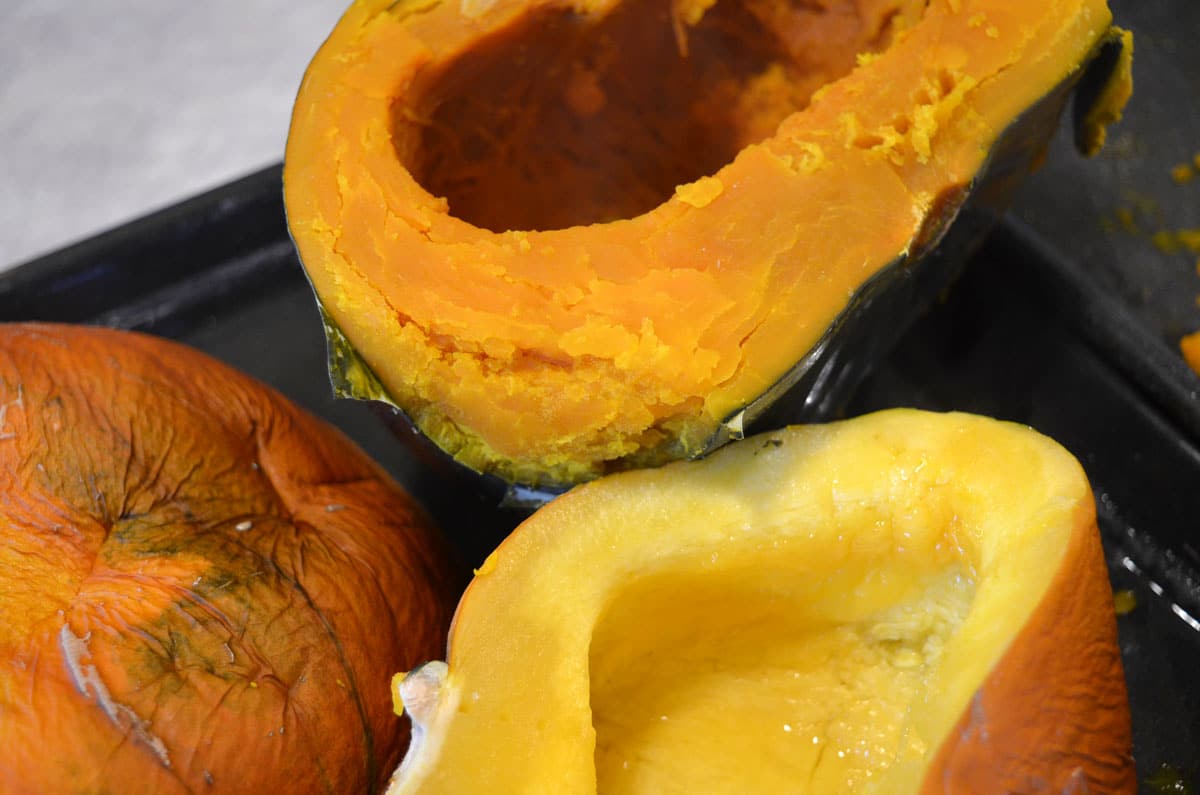
How to Cook Pumpkin in the Oven
Baking pumpkin or squash in the oven in the option is the option I use most often. It’s easy to do, and warms up the house in winter.
All you have to do is:
- Preheat oven to 350°F (180°C).
- Cut pumpkin in half and scoop out the seeds and and stringy stuff.
- Place pumpkin halves cut side down in roasting pan or baking sheet and add about 1/4 inch (1.5 cm) of water.
- Place pan in the oven and bake for about 45 minutes to one hour, until you can easily pierce the flesh with a fork. Smaller fruit may take less time.
- Remove from oven and let cool enough to handle. Scrape pumpkin out of skin and mash or puree for use in recipes.
Note: If your pumpkin is a high moisture type, you can probably skip the water in the bottom of the pan.
Because I cook mostly squash with drier flesh, if I don’t add a little water, they will scorch a bit. Placing the pumpkin cut side down traps steam inside the fruit, speeding up cooking time and cooking it more evenly.
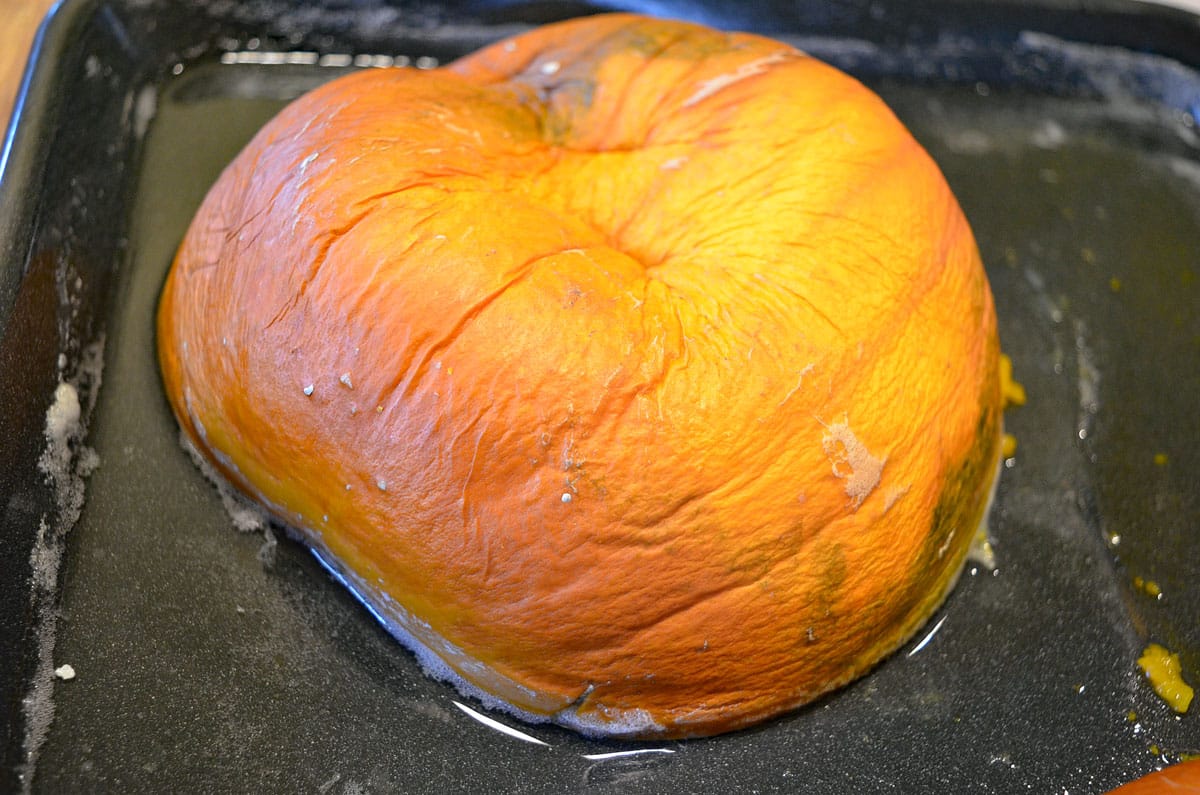
Andrea Chesman notes in “The Garden Fresh Vegetable Cookbook“:
“Most recipes call for cutting winter squash into pieces. Some winter squash, like blue Hubbard, require a heavy cleaver (or ax) to do the job. Others, such as Delicata, have skins that are easily cut or even edible. Butternut can be peeled with a swivel-bladed vegetable peeler.
For a very hard squash, the best thing to do is drop it on a concrete floor or paved driveway.
Another way is in the microwave. Place the whole squash in the microwave and cook on high for 2 minutes. Allow the squash to stand for several minutes, then cut in half for further cooking. After cutting the squash, remove the fibers and seeds.”
Can you put a whole pumpkin in the oven?
Yes, you can cook pumpkin whole. Just cook it a little longer.
If the rind is easy to cut through, I find it easier to remove the pumpkin guts in the beginning. If the rind is hard to cut, I bust off the stem and put the fruit in the oven whole (if it fits).
Make sure you poke a few ventilation holes in your pumpkin if you cook it whole, to eliminate any chance of having a blowout.
Would you like to save this?
How to Cook Pumpkin on the Stove Top
If you don’t have access to an oven, you can cook pumpkin on the stove top.
- Cut pumpkin in half and remove seeds and strings.
- Cut pumpkin into chunks and peel.
- Place pumpkin chunks in a large saucepan or stockpot and fill with enough water to cover bottom of pan/pot.
- Cook pumpkin on low for about 25 – 30 minutes, stirring occasionally, until soft. You may also mash the pumpkin right in the pan and cook off excess moisture.
- Strain to drain off excess liquid if needed, cool and purée.
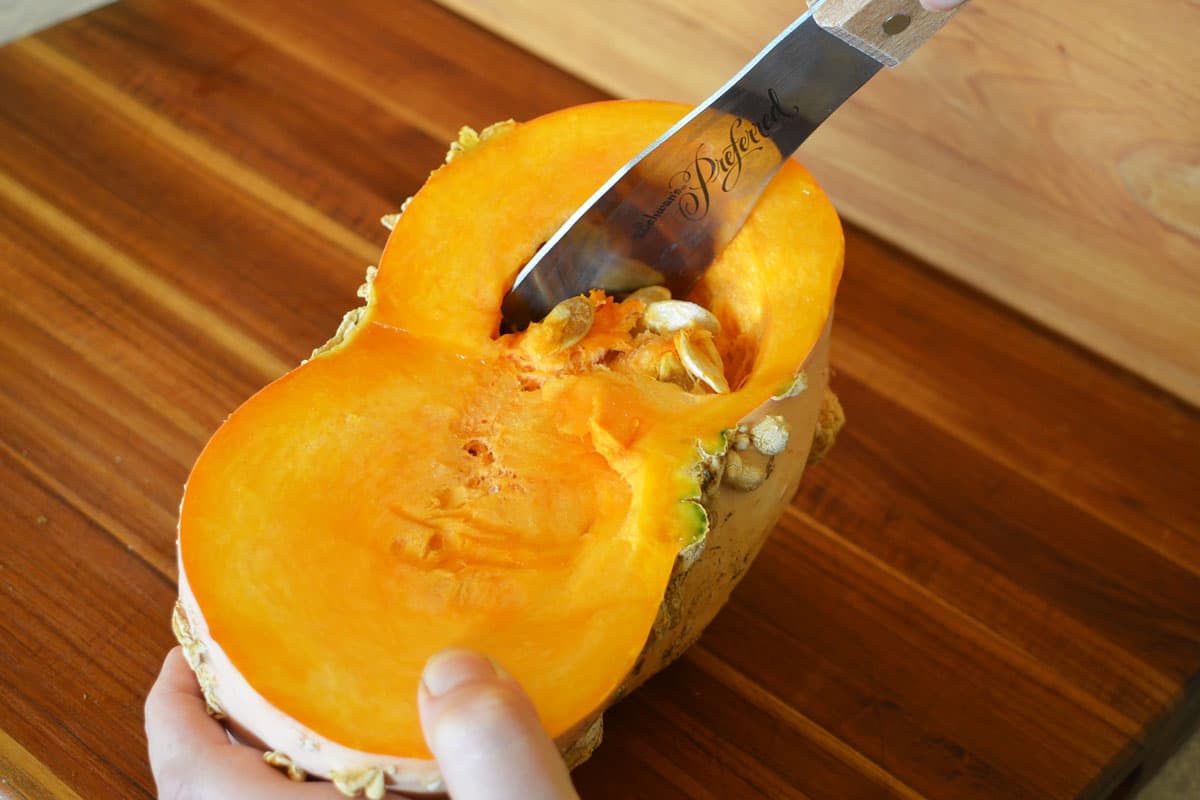
How to Cook Pumpkin in the Microwave
I’m not much of a microwave cooker myself, but I know some folks use them for everything. The drill for microwaving pumpkin is similar to other cooking methods.
- Cut pumpkin in half and clean out the pumpkin guts.
- Place cut pumpkin in a microwave safe cooking dish with about an inch of water in the bottom.
- Cover and cook pumpkin in microwave on high for 15 minutes. Test tenderness. Microwave in 5 minute intervals until pumpkin tests done.
- Remove from oven, cool, scoop out flesh and purée.

How to Make Pumpkin Purée from Pumpkin
I usually scoop the cooked flesh of the pumpkin into the food processor and purée until well blended. You can also use a blender, a stick blender or even a potato masher. Finished pumpkin purée should be smooth and creamy.
Sometimes winter squash is so dry that it doesn’t get creamy, and you need to add a little bit of water. Another option is to mix half pumpkin and half squash.
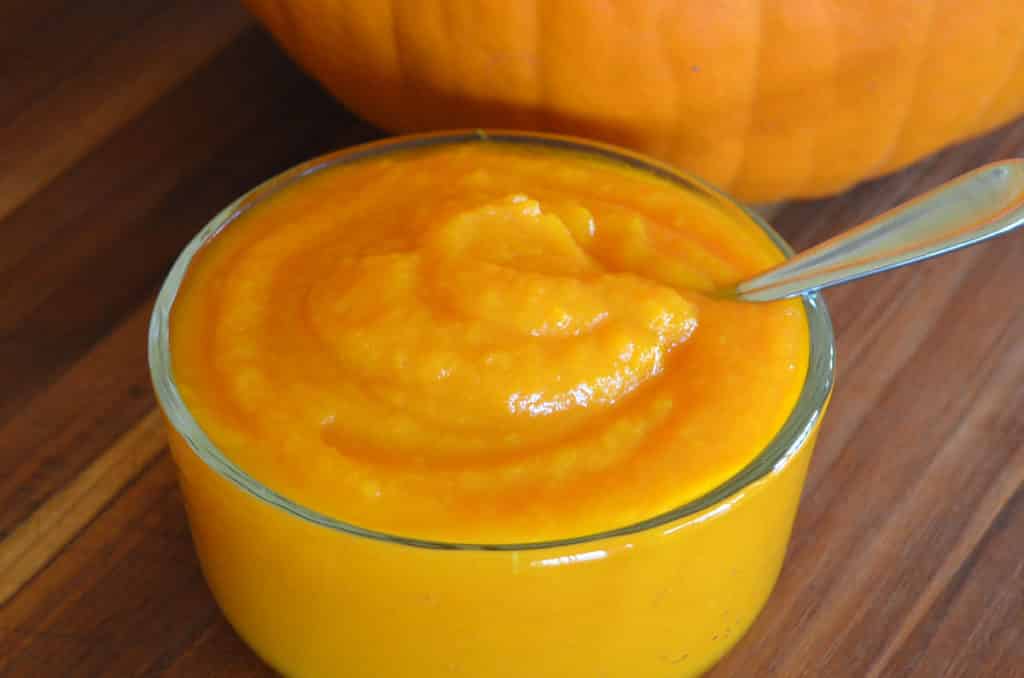
How Much Purée Does One Pumpkin Make?
1 pie pumpkin (around 6 pounds) = 2 cups cooked and strained purée
A similar size winter squash will typically yield a little more purée. Pumpkin (squash) purée freezes well.
I like to cook up a big squash (or several smaller ones), and purée them all. Then I freeze the puree in portion sizes for the recipes that I use most. You can also store purée in the refrigerator for about a week.
Family Favorite Pumpkin Recipes
Some of our favorite pumpkin recipes include:
- Pumpkin Spice Waffles with Maple Cinnamon Whipped Cream
- Pumpkin Fruit Leather – Tastes Like Portable Pumpkin Pie
- Soft Pumpkin Oatmeal Cookies with Cranberries and Walnuts
- Easy Pumpkin Pie with Graham Cracker Crust
- Pumpkin Spice Scones Recipe, Plus the Secret to Successful Scones
- Mom’s Best Pumpkin Bars
For tips on using the seeds, see Pepitas vs Pumpkin Seeds + Benefits & Recipes.
Once you’ve tried home cooked pumpkin, you won’t want to go back to canned. Plus, pumpkins store well and make a great inexpensive pantry staple. Our ducks and chickens love them, too. (Adding cooked pumpkin to their diets helps keep those yolks bright orange.)
Have any questions or pumpkin cooking tips? Just leave a comment below.

This article is written by Laurie Neverman. Laurie grew up in the kitchen, learning baking and home cooking from her momma. At age 15, she and her mom and two sisters created Irene’s Custom Cakes & Catering. This was her summer job through most of high school and college.
Originally posted in 2017, last updated in 2025.



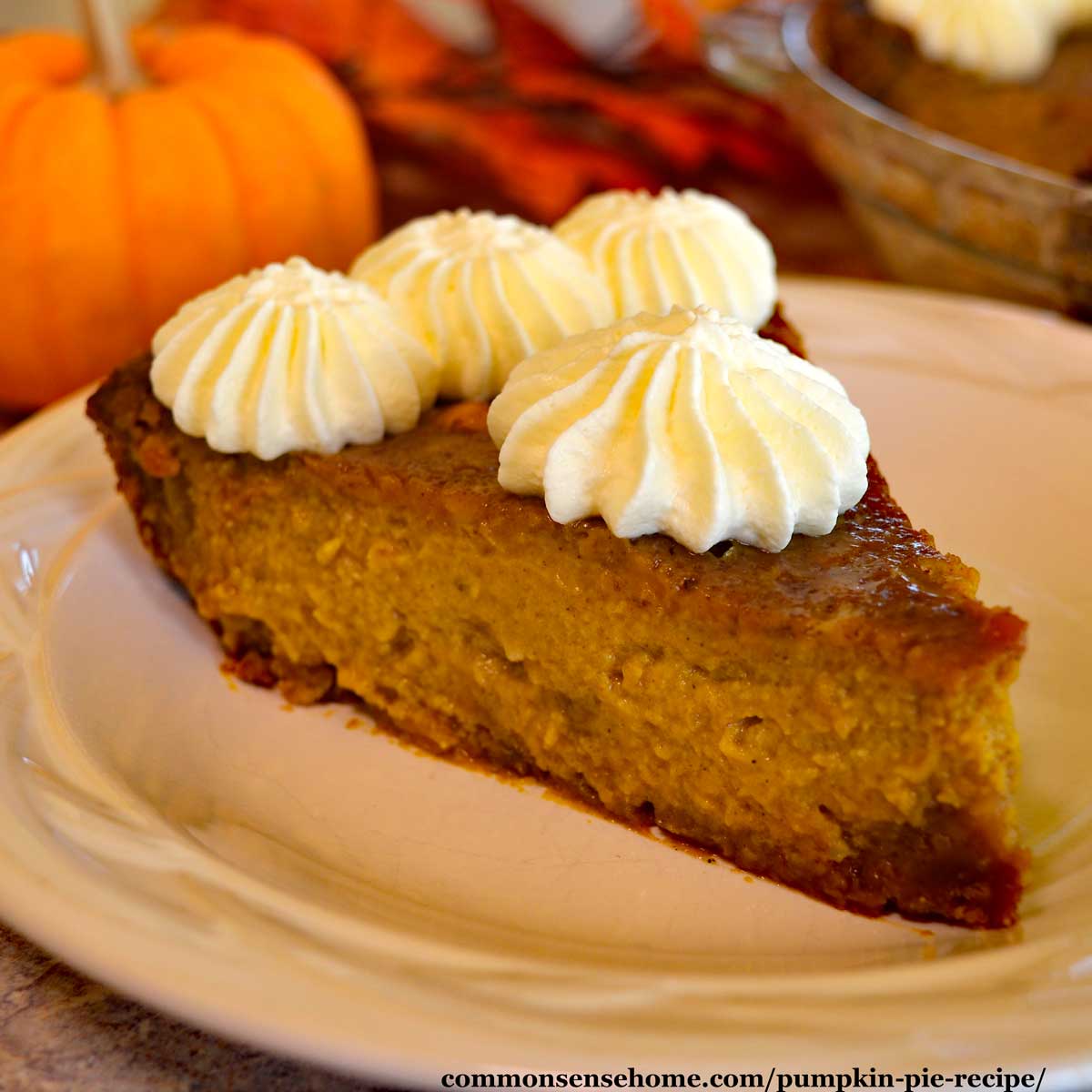
I almost always use butternut squash in most of my ‘pumpkin’ recipes. I recently discovered the seeds are real tasty too. It’s never too late to learn something new
A well travelled friend gave me some seeds for the Australian Queensland Blue pumpkins and they are the BEST ever!!! I had a bumper crop the last 2 years. I cut them in half, scoop out the seeds and cook them face down on a cast iron pan or griddle. No need to add water. They are sweet and delicious and don’t have the strings in the flesh like most pumpkins. Aside from just eating as is, they make pumpkin pies like no other. Now, the Australians don’t know of pumpkin pie. LOL. They use them for soup. And pumpkin is a healthy treat for my dog. Just thought I would share.
A friend of ours grew those a couple years ago and gave us one, and I agree, they are delicious. It’s interesting to me to see how crops (and their uses) have changed as they’ve moved around the world.
I have used spaghetti squash in pumpkin pie recipes. The texture seems novel to a ot of people, but it’s the same stuff.
Thanks for all the instructions! I have to tell a little secret…my husband does not like winter squash, but he does love pumpkin pie…go figure. Anyway, he doesn’t know it, but I have been substituting butternut squash for pumpkin now when I make my “pumpkin pie” and he is none the wiser! In fact, he says my pies are better than ever. My pumpkin bread too! Should I tell him the truth? Nah. I suppose if he spent more time in the kitchen with me, he might know better 🙂
My husband’s not much of a squash or pumpkin eater, either, but likes it well enough as a recipe ingredient. House rules are that if someone else is cooking, you lose all rights to complain about the food.
Yay – great rule!